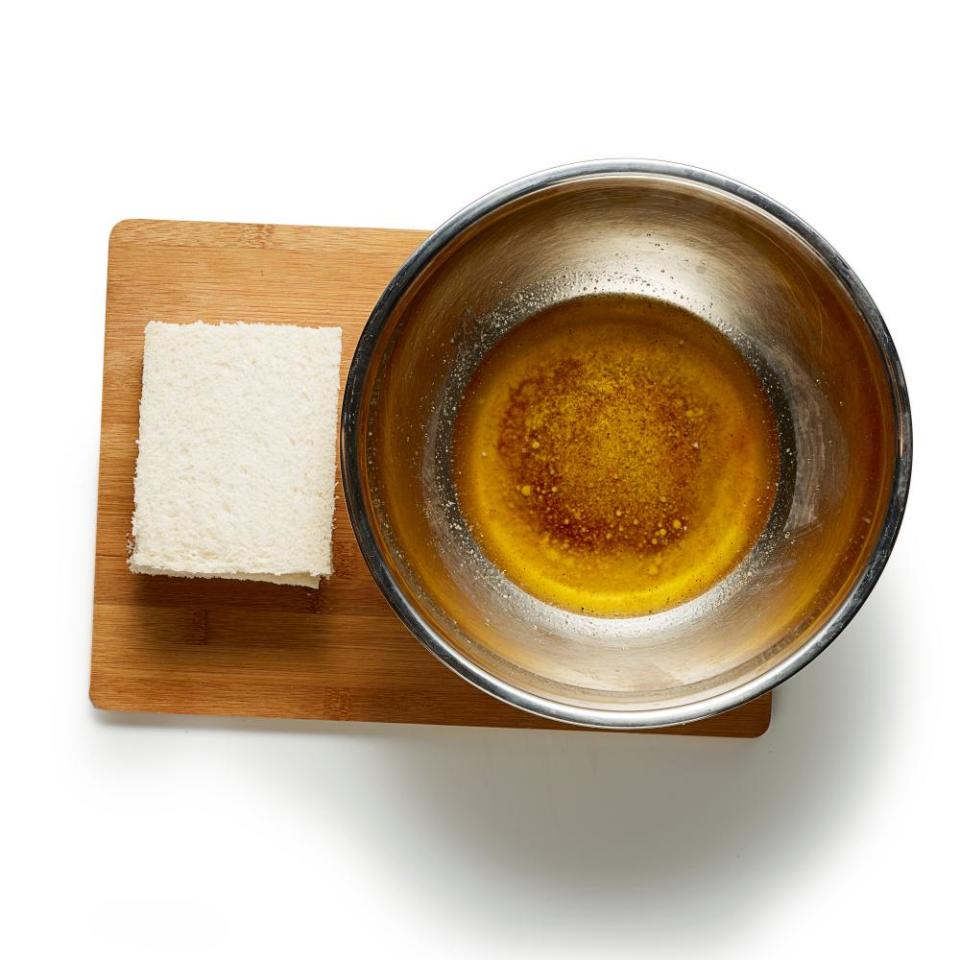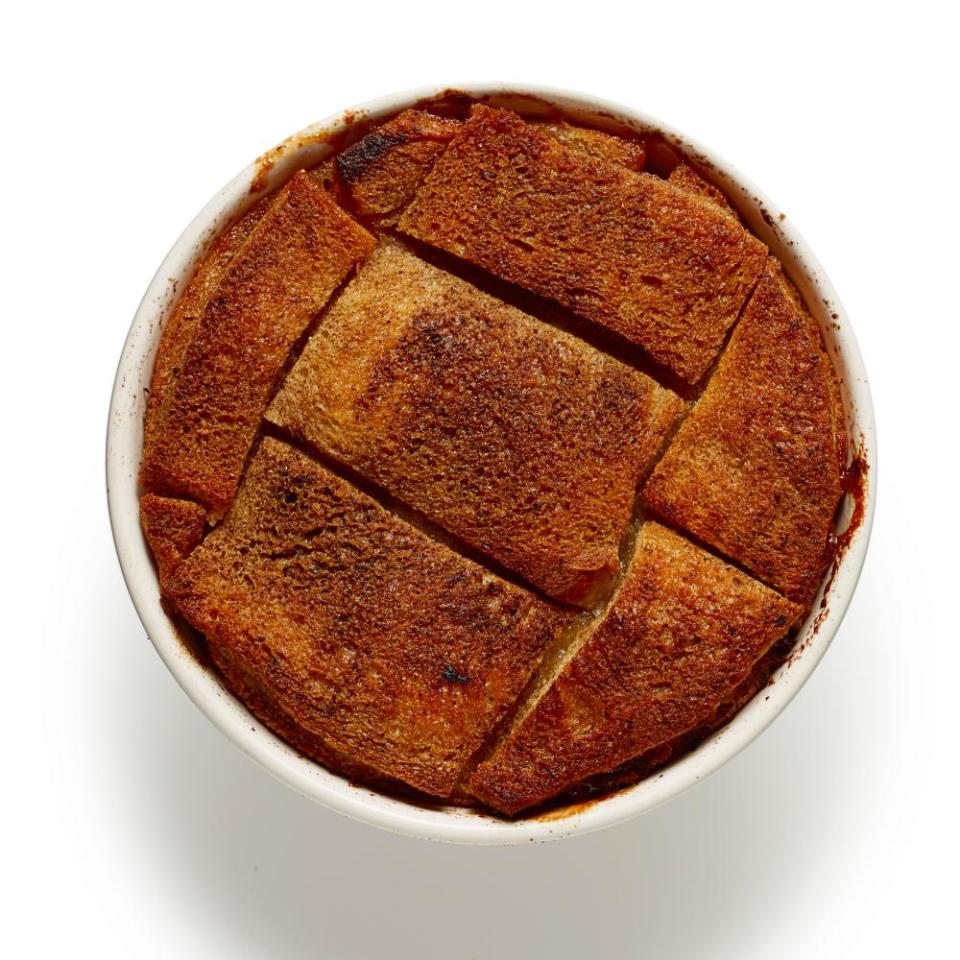How to make the perfect apple charlotte – recipe
Often described by those who don’t know any better as a “classical French dessert”, apple charlotte is actually more likely to be one of our own – the similarities to summer pudding are unmistakable. Stewed fruit and stale bread is just a very British vibe somehow, especially when it’s served up smothered in custard.
The ever diligent Regula Ysewijn explains in her book Pride and Pudding that, despite attempts to credit it to the superstar 19th-century chef Marie-Antoine Carême, the first print recipe for apple charlotte appears in John Mollard’s 1802 The Art of Cookery Made Easy and Refined, probably named after the wife of King George III, at a time when Carême was still a mere apprentice.
As this pedigree suggests, this is an elegant dish perhaps more suited to dinner parties than crumbles or pies are; the kind of thing at home on the tables of royalty, back when British royalty was known for more than its thrifty ways with cornflakes. Happily, it’s also both pretty cheap and very simple to make, even without the palace kitchens at your disposal.
The apples
In common with many seasonal fruit recipes, my instinct is to suggest you use whatever you have to hand; once sweetened to taste, all apples will work here. That said, those apples should certainly be cooked before use – I try one recipe, from Mary Norwak’s The Farmhouse Kitchen, that puts the apples into the oven raw, but this makes for results so dry, if delicious, that we have practically to drown them in cream to make them palatable (which, of course, only makes them more delicious, but that’s hardly the point). As Anne Willan notes in French Regional Cooking, “the key to making a successful apple charlotte is to reduce the apple puree thoroughly so that the charlotte does not collapse when unmoulded”. If your mixture is too liquid, it will seep through the bread walls and undermine the structural integrity of the entire edifice.
Anthony Demetre calls for “firm-fleshed apples, such as cox’s, spartan or jonagold” in his book Today’s Special, and Darina Allen, whose recipe for this “scrummiest, mostly wickedly rich apple pudding” is borrowed from her friend Peter Lamb, recommends cox’s, though, like Ysewijn, who prefers granny smiths, Allen concedes that bramleys can also be “very good”.
Cooking apples such as bramleys have the distinct benefit of breaking down easily when heated, giving a smoother fluffier puree. They can lack the complexity of flavour of some eating varieties, but initially I decide this is worth the sacrifice for their beautifully silky texture, but actually, as I learn the hard way, it takes a very long time to reduce them sufficiently to guarantee that your charlotte will stand up.
Eating apples it is, then – I’d recommend choosing larger examples, if possible, to minimise the time you have to spend extracting the core. (If you only have cooking apples, reduce them as much as possible, and consider adding the cores and skins to the pan during cooking, to increase levels of pectin and give the puree a firmer set.)
The flavourings
As we’ll be using plain bread, rather than sweet pastry, you’ll need to add sugar to the apples, unless they’re already very sweet or you have Spartan tastes – though you could do this in the form of jam, if you prefer, in obedience to Ysewijn’s recipe, which is based on Mollard’s original. I rather like this, but my testers complain that it makes the whole thing taste of apricots rather than apples, so I abandon the idea in favour of Norwak’s demerara sugar, which is always a flavour that works well with apples. I am, like Mollard and Ysewijn, going to add a slug of booze – he likes brandy, she suggests brandy or dark rum, while Willan cooks her apples in white wine, “preferably Jura ‘vin jaune’”. Apple brandy is, I think, the best call if you happen to have some knocking around, but otherwise most brown spirits or white wines will work – if you’d prefer to keep it alcohol free, just add a little more water, or apple juice, if need be.
Willan and Norwak both add a pinch of cinnamon to the dish, which is a classic pairing with apple, though you could use any sweet spice that takes your fancy (cloves, ginger, nutmeg or mixed spice all strike me as good combinations), as would a hint of lemon zest, which is my own addition. Allen beats egg yolks into the fruit to give it a lovely, rich roundness, but we think the same result can be achieved with more butter with no need for an extra ingredient.
It may well be too late for this season, but Demetre and Norwak both add blackberries to their charlottes, with the former also making a blackberry sauce, cooked with lemon juice and icing sugar and then passed through a sieve. My testers are big fans of these but, for me, they outshine the apples; if you have them, by all means stick them in (or, even better, make Demetre’s sauce, so you can add it to taste), but I prefer the dish without. If you’re keen on the idea of extra fruit, you might also like to consider Mollard’s dried cherries, which are less likely to bleed into the apples in the oven.
The bread
I’m very tempted to try the black bread apple charlotte from Elena Molokhovets’ 19th-century A Gift to Young Housewives, but on reading the recipe, it doesn’t quite fit the bill – all the British and French versions I find call instead for soft white bread, often stale, though actually I find it much easier to work with if it’s fresh. That said, I’m sure most plain or indeed fruit breads would be delicious.
One of the key differences between a charlotte and a summer pudding is that the charlotte is baked, which means the bread needs to be buttered to prevent it burning. To no one’s great surprise, the more butter, the more crisp and delicious the results. Allen and Willan clarify their butter first, skimming off the milk solids to leave the pure fat, which makes it less prone to burning at high temperatures. It’s not a must, but it will make your charlotte look more attractive on the plate – and, if you’re really keen to impress, consider using beaten egg white to stick the bread together, as Allen suggests. I’m going to add spices to the butter, so the bread doesn’t feel like the plain relation, but stick them in the apple instead, if you prefer.
Rather than using bread, Demetre goes down a more charlotte russe route, encasing his apples in instead. They’re very nice, but don’t soak up the butter in the same way as the bread, making the whole thing less rich and crunchy. Norwak, meanwhile, goes for the kind of charlotte my parents both recall from childhood, namely, layers of fruit and crunchy, buttery spiced breadcrumbs, making hers more like a bread-based crumble. We’re all very into this, but it cannot be denied that it’s an entirely different dish.
The mould
To make this a truly elegant dinner party dessert, you might like to consider making these in individual dariole moulds, as Demetre suggests, though I like the drama of turning out a large golden pudding at the table – in the absence of a charlotte mould, a pudding basin will do, as would a loaf tin, as Allen recommends, if you don’t have one of those – just adjust the amount of bread and apple accordingly. Finish with a further sprinkle of crunchy demerara sugar, and serve with liberal amounts of custard, cream, ice-cream or, as chef Jeremy Lee does at London’s Quo Vadis restaurant, all three at once. It’s that kind of autumn, after all.
Perfect apple charlotte
Prep 35 min
Cook 1 hr 35 min
Serves 6
1.5kg apples, preferably firm eating apples such as cox’s or similar
175g butter
75g sugar, preferably demerara, plus 2 tbsp extra to finish
30ml brandy, or golden rum or whisky (optional)
Grated zest of ½ lemon (optional)
1 pinch ground nutmeg, or cinnamon, ginger or mixed spice (optional)
8 slices medium-thick soft white bread
Peel and core the apples, then cut them into thin slices or cubes (it doesn’t really matter which, because they’re going to be cooked down into a puree). Melt 75g butter in a large pan over a medium-low heat, add the apples, sugar, alcohol (if using) and a tablespoon of water (you may need to add more later if you don’t use the alcohol, so keep an eye on it), then cover and cook, stirring occasionally, until soft and beginning to break down.

Uncover and leave to cook until you have a very thick and pulpy puree; stir regularly, so it doesn’t catch and burn (this process took me almost an hour from start to finish).

Grate in the lemon zest, taste to check the sweetness and adjust as necessary, thenleave to cool while you prepare the bread.
Heat the oven to 200C (180C fan)/390F/gas 6. Melt the remaining butter over a low heat and skim off the foam.

Once you see pale solids in the bottom of the pan, carefully pour off the clear liquid above into a clean, heatproof container, preferably through a fine sieve, and discard the solids. Add a pinch of spice, if using, to the liquid butter.
Cut the crusts from the bread. Find an ovenproof mould (a pudding basin or a bread tin) with a capacity of about one litre, then cut the bread into rounds or strips to line it (or six individual ramekins); if your mould is round, bear in mind that you’ll probably need some little triangles to fill in the gaps, and factor in that you’ll need more bread for the lid, too.
Remove the bread from the mould(s), dip each piece in turn into the melted butter, then use to line the dish(es).

Spoon in the apple puree, then top with the final piece(s) of bread, also dipped in butter. Bake for 15 minutes, then turn down the heat to 180C (160C fan)/350F/gas 4 and bake for about another 40 minutes, or until the bread on top is golden.

Leave to cool in the mould for 10 minutes, then turn out, scatter with sugar and serve with cream, custard and/or ice-cream.
• Apple charlotte: French or English? Bread, sponge or crumbs? How do you like yours, and what do you flavour it with? And which other apple-based treats are on the menu in your kitchen at this time of year?

 Yahoo News
Yahoo News 
